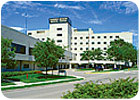
Maintenance staff at the Shawnee Mission Medical Center in suburban Kansas City sought to lessen the burden and cost of cooling tower maintenance. After overcoming some hesitancy, they eventually turned to pulse-power water treatment.
Hospitals have to work extra hard to maintain clean, efficient cooling towers. Longer cooling seasons, overall volume, and the ever-present concern over Legionella makes cooling tower maintenance particularly challenging for health care facilities. To lessen the burden and cost of cooling tower maintenance, the Shawnee Mission Medical Center in suburban Kansas City, turned to pulse-power water treatment (PPWT) and found surprising success.
Kelly Griffith, mechanical coordinator for the hospital, is a cautious proponent of new technology. Although intrigued by a presentation from Clearwater Systems on PPWT, he was hesitant to request capital expenditures from the hospital without first testing the technology. So he decided to test Clearwater’s Dolphin Series non-chemical water treatment system on a separate administrative facility served by a 70-ton cooling tower. If, after 120 days of operation, the Dolphin System lived up to the manufacturer’s claims, Griffith would not only buy it, he’d consider it for the hospital’s other cooling towers.
PPWT addresses three major concerns in cooling tower water: microbial growth, scale, and corrosion. The inline Dolphin Series device works by delivering high-frequency electric pulses through which the cooling tower water flows. These pulses change how calcium carbonate (the primary source of pipe scale in a cooling tower system) and other dissolved minerals precipitate out of water.
Instead of precipitating out as material that becomes pipe scale, the electronic pulses cause calcium carbonate to precipitate as a powder, which remains solvent and is easily removed at blowdown. These pulses also help to break down existing scale, so that it, too, may be removed from the system. PPWT impedes bio-growth by injuring the reproductive capability of existing bacteria, making it impossible for them to multiply.
‘Like A Freshly Cleaned Swimming Pool'
Griffith knows that cooling towers by nature are not the most aesthetically pleasing pieces of mechanical equipment. They also tend to be quite odorous, at least at close range, due to a combination of the cooling tower water itself and the chemicals used to treat it. So he was surprised when, after a four-month trial period using the Dolphin System, he found the water in his 70-ton cooling tower to be as clear and non-odorous as a freshly cleaned swimming pool.“We didn’t perform any water quality maintenance on the cooling tower while testing the Dolphin unit,” said Griffith. “We pulled the plug on the chemical pumps at the beginning of the trial period and monitored the water every day. We never needed chemicals again.”
Griffith also noticed that the mineral deposits in the tower had begun to disappear. At the end of the test period, Griffith and his staff opened up the chiller for its seasonal inspection and cleaning and also found the heat transfer surfaces free of scale.
With the Dolphin’s trial success under his belt, Griffith decided to put the system to an even tougher challenge: a process water cooling tower that served an incinerator on the hospital campus.
“This particular tower had incoming water temperatures as high as 120°F, which really incubates bio-growth. I knew if the system would work on that, it would work on anything - and it did,” said Griffith.
After monitoring the operation for several months, Griffith found this second installation to be just as effective at reducing bio-growth and scale as the first test unit. It was enough to convince Griffith to add additional Dolphin units onto the hospital’s main facility cooling towers and specify them for an $84 million expansion currently underway at the medical center.
